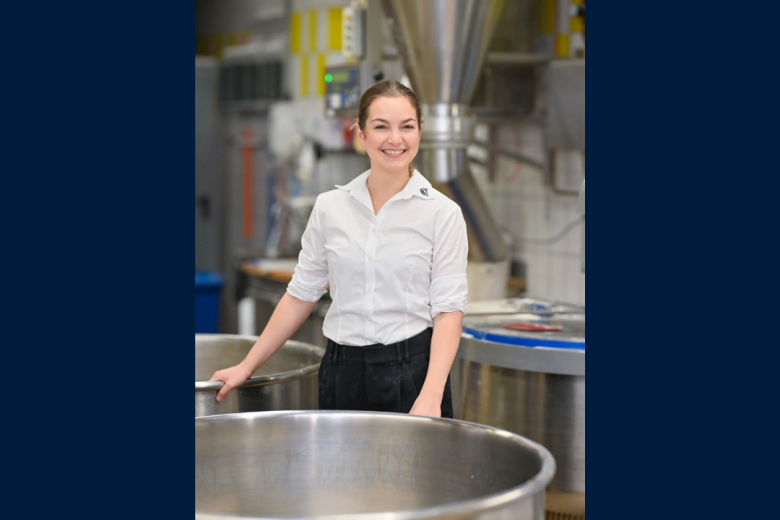“This is the jewel in the crown of our work in the sciences”
The new Center Court on the Brightlands Chemelot Campus in Sittard Geleen was officially opened on 16 November. “The building was finished much earlier than expected”, says a proud Thomas Cleij, Dean of Sciences, from behind his desk in his brand new office. He was involved in the project from the very beginning. The entire process, from design to construction, took more than four years. “When I walk through the corridors here, I recall every meeting about every single pillar.”
He has nothing but praise for the view from his office. “The green of the trees combined with the chimneys of industry – it’s exactly the kind of landscape that suits the Biobased Materials research group.” He is referring to the Maastricht University (UM) contingent in the building: researchers as well as students from the Biobased Materials master’s programme and the Maastricht Science Programme (MSP) bachelor’s. The building also houses the Chemelot Innovation and Learning Labs (CHILL), the team of the Brightlands Chemelot Campus, and the DSM Innovation Center and Chemelot Ventures.
Viable
Cleij hopes this will ultimately be one among many UM buildings on the campus. His task, as Dean of Sciences, is to look for new opportunities for UM to profile itself in the sciences. “The sciences are interfaculty in Maastricht; in systems biology, for example, the Faculty of Psychology and Neuroscience, the Faculty of Humanities and Sciences and the Faculty of Health, Medicine and Life Sciences all work closely together. To develop a coherent policy in the natural sciences, someone has to try to organise that synergy between the different faculties. While I’m Vice Dean at the Faculty of Humanities and Sciences and holder of the Sciences portfolio, my real task is to find synergies and try to organise the required funding. Many initiatives are currently supported by grant money, but that will dry up at some point and then you have to make sure it stays viable.”
Rectangular labs
The first discussions about the construction of the Center Court were held in 2012. “First we had to give an indication of how many square metres we’d use. That was difficult; we only started with the sciences in 2011 and still had little data on student intake in the MSP. Now we’re renting almost 2000 square metres, with over 80 staff members and 260 students.”
The shareholders (UM, DSM and the Province of Limburg) met regularly to exchange ideas. Once they came up with a plan of action and requirements, Ector Hoogstad Architects got to work. “At some point you find yourself sitting down at the table with the architect. I had particular ideas about types of labs. Most labs in the Netherlands are square, but I wanted longer, narrower ones. That struck me as much safer and more efficient. You can see everything from one vantage point; there are no blind spots. But rectangular labs would have an impact on the shape of the building and even the supporting steel structure. We went through dozens of drawings and types of buildings. It’s really fun, kind of like building with Lego.” The rectangular teaching labs materialised in the end, perpendicular to the corridors. “I’m happy they worked out. Especially since I’ve never designed a lab before”, he laughs.
The architect did fantastic work, in Cleij’s view, on the public areas in particular. “It’s a nice building with quiet seating areas and busy parts where you can sit and have meetings. Otherwise it’s still a bit sterile, but our students will dress it up a bit. We plan to decorate the second floor and hang up portraits of Limburg scientists, which will give people an idea of what went on here in the 18th and 19th centuries.”
Milestone
Cleij is clearly proud of the building, which he sees as boosting UM’s image and profile. “The building is the jewel in the crown of our work in the sciences over the last few years. The MSP has proven viable and is holding its own in the sciences. We have our own building with beautifully equipped labs, and the programme is now officially recognised. The Master in Biobased Materials, which we launched last year, now also has its own space with a lecture hall and the whole works. And the Aachen-Maastricht Institute for Biobased Materials (AMIBM) will be relocating here soon. This is not just something on paper to help us win grants. These are major, physical projects that give UM a strong presence not only in Maastricht, but in wider Limburg. That’s really a milestone.”
The Center Court will be officially opened by the King’s Commissioner for Limburg, Th. J.F.M. Bovens, and Director-General Dr B. Leeftink from the Ministry of Economic Affairs. The shareholders were represented by Professor M. Paul, president of Maastricht University, A. Nicolaï, director of DSM Nederland and A.M.G. Beurskens, member of the Limburg Provincial Executive.
Video: A short tour of the Center Court by two MSP students.
Also read
-
Flour, family, and forward thinking: the evolution of Hinkel Bäckerei
In the heart of Düsseldorf, the comforting aroma of freshly baked bread has drifted through the streets for more than 130 years. Since its founding in 1891, Hinkel Bäckerei has evolved from a small neighborhood bakery into a cherished local institution.
-
The University Fund Limburg's new Annual Fund Campaign is live!
Every year during the holiday season, the UM community comes together to uphold a special tradition: supporting projects that contribute to a healthier, fairer and more sustainable society. Will you join us?
-
A new wave of talent emerges from the School of Business and Economics
On Sunday, November 30, 2025, the Maastricht University School of Business and Economics (SBE) proudly celebrated the achievements of over 1,461 graduates from both bachelor’s and master’s programs. The festive ceremony took place at the MECC Maastricht and marked a significant milestone for the SBE